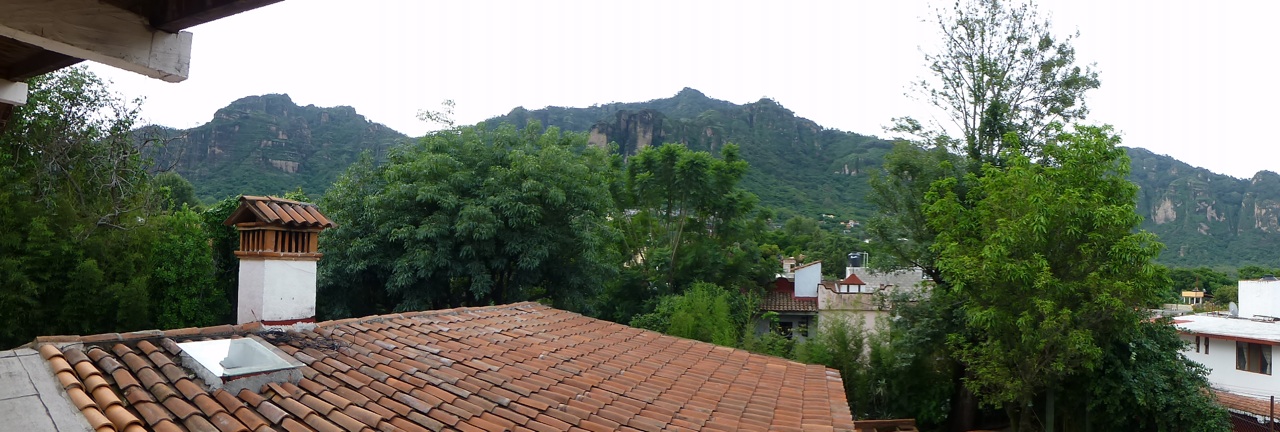Three EA gigs in Mexico
Just thought I’d give a quick update on some of the work I’ve been doing here in Mexico with my colleague Michael Smith over the past couple of weeks.
But first, in the tradition of Alex Osterwalder, here’s a panorama from the balcony of the office here in Tepoztlan, about an hour west of Mexico City:

(Click on photo for larger-scale view. What doesn’t come across well in the photo – even in the larger view – is the size of that mountain-range just in the background: it rises for some 1500ft or more, barely a mile or or so out of town, and some of those bare-rock-face cliffs you can see there are a more-than-500ft sheer drop…)
Most of what we’ve been doing together on this brief trip has been ‘spot-work’ – one- to two-day consultancies, often in support of other consultants. It’s covered a very wide range of business-needs, as you might expect, but the three main gigs – a venture-capital team and investment-bank, a community, and a primary-school – have all shared something in common: a need for clarity on business-identity and purpose. As you’ll note from your reading of TOGAF and the like, it’s something that’s not handled well – if at all – in most mainstream ‘enterprise’-architecture: yet if we don’t do that work, we’d end up building an architecture upon arbitrary and possibly-unfounded assumptions – which is not a good idea! Which is why this part of the work is kinda important…
In each of these cases the consultancy-sessions centred around the ‘Service Context’ component of Enterprise Canvas – the map of enterprise-stakeholders that Michael nowadays refers to as the ‘holomap’:
Although I can’t show the details – for obvious confidentiality-reasons – what was interesting was that in each case the clients made the model very much their own, adding sections to the model to explore additional themes, such as the multi-sided nature of the enterprise for the venture-capital group and the school, and engagement with nature and with environmental-research for the community.
(In credibility-terms, there’s a kinda difficult trade-off here. In some ways it’s better to have a pre-printed template, such as the large-size sheets that Michael has often used in his own workshops – see the post ‘Tools in action‘ for some examples. But in other ways it’s perhaps better to get the participants to use the diagram above just as a kind of guideline base-template, and draw their own model from there, in their own way – because doing so will greatly increase their engagement in and ownership of the resultant model. Horses-for-courses, really: what’s best in each case is the kind of spot-judgement about the participants’ needs and expectations that only come from experience in real-world consultancy-practice.)
In all three cases the aim had then been to use the model to lead on towards finding a unifying vision (or ‘promise’, or ‘invitation’) and concomitant values and core-principles that would provide a link between all of the stakeholder-groups identified in the holomap. We did actually achieve all of that within the one (long!) day in two of those cases, but in the third case, what the model highlighted instead was some fundamental clashes in perspective between some of the participants – which meant that Michael had to shift over to a more classic management-consultancy mode to resolve that instead, before moving on. (I’ll have to admit here that whilst Michael’s soft-skills were well up to handling the kind of emotional-overload that happened in that latter case, my own aren’t: it’s why I work more as a ‘toolmaker’ than a mainstream management-consultant, and why my main client-base is other enterprise-architects, rather than direct with business-executives and the like. But I digress…) What the model did do, though, was provide a common frame of reference around which those clashes could be resolved – so was definitely of real value even there.
Another theme that this work reiterated was the value of seeing models as ‘decision-records’, rather than as the core outcome of the exercise. The model itself, whilst useful, is much less important than the process of arriving at the model – the process of exploration and development of shared-understanding that arises from the conversation itself. The model thence becomes, for the participants, an emotive anchor – and hence, literally, a motivational one – for guidance and future decision-making based on the shared-decisions that were achieved during that process. We often talk about ‘alignment’ in enterprise-architecture: that emotive-commitment is what real-world ‘alignment’ looks like – and is – in a human sense.
I’ll leave it at that for now: just a ‘work-in-progress’ report, really. But hope it’s useful, anyway – and over to you for comment, perhaps?

Leave a Reply